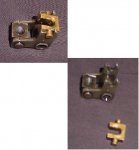Re: 65hp chrysler (1978) gearbox
Hey there Gilly! How did the piston clean-up?
ALL larger Chrysler and non-Mercury Force lower units use that same yoke--AND-- there was a steel one offered at one time. If you want a steel one, ask Franz, at franzmarine .com. He probably knows if they are still available.
However, it is possible to adjust the linkage with too much throw into either gear and this will put additional pressure on the yoke causing undue wear.
The yoke has no shims or clips because due to the design, it can not slip out of position once assembled correctly.
When reassembling, use a heavy grease to hold the yoke to the center shaft. Leave the top of the lower unit open so you can see down--it makes it way easier. Pull up on the shift rod to move the other steel pivot forward (actually reverse position). Slide in the drive shaft/forward gear and yoke and engage the pivot with the two ears on the yoke. Do not move anything until reverse gear and bearing carrier is in place. Then check the action by moving the shift rod through forward and reverse positions. The shift rod itself should be screwed all the way into the pivot and only backed out enough to match the hole on the connecting block at the top.
NOW, after re-attaching the lower unit, adjust the shift linkage so there is the same movement from neutral to forward and neutral to reverse. Check this by marking the rod in neutral and in forward and reverse. I forget if that engine has clearance or not; you may need to mark the connecting block rather than the lower rod. At any rate, the important thing is that the lower rod which goes into the lower unit has the same throw both ways. Total throw is designed into the linkage and can not be changed--only the ratio of forward to reverse can be.
Finally: A word to the wise: Take it on good authority; those lower units had small gears for the horsepower. That engine developed magnificent torque at low speeds and it is really easy to overload and tear out the gears. Using a too small pitch prop will allow the engine to develop its torque and horsepower too fast and on a hole shot, it will strip the gears almost immediately. I know. I ran my 60 for several weeks with a 10 x 13 prop with no problems. As soon as I switched to a 10 X 12 prop, I stripped the gears with the first hole shot, full throttle acceleration.--within 5 seconds! BTW: that 60 does 45 MPH on a 14 foot closed deck boat--that ain't too shabby! But, while it has the power, I would not use it for water skiing.
The engine block itself was the epitome of cross flow design with long rods, packed block, large displacement, through piston skirt porting, massive bypass and exhaust ports, equal length exhaust runners, and twin carbs.--A real beauty. Too bad Chrysler did not extend that design to the 3 and 4 cylinder engines. Would have really given Merc and OMC a run for their money.
So, you need to take care of that lower unit since like pistons, no gears are available and not too many used lowers come on the market. If at all possible, accelerate slowly until the boat is on plane. Once the boat is on plane, load against the gears lessens and you should be ok for full throttle performance.
 i read a book and it told me how to put back together, i have to remove the reverse gear and put it in last to be abble to re assemble. the rest of the box looks fine. any help would be awsome.
i read a book and it told me how to put back together, i have to remove the reverse gear and put it in last to be abble to re assemble. the rest of the box looks fine. any help would be awsome.



















